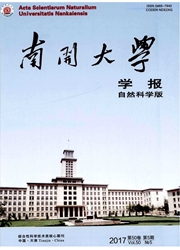

 中文摘要:
中文摘要:
用常规DSC及TOPEM技术研究了丝素蛋白-粘土纳米复合材料的热力学及动力学行为,丝素链的松弛动力学可以用玻璃化转变过程中的有效活化能(Ea)及协同重排尺寸(Vg)来表征.与纯丝素蛋白相比,复合材料的玻璃化转变温度向高温移动,有效活化能显著提高,同时丝素蛋白-粘土的协同重排体积也有显著提高.有效活化能和协同重排尺寸的增加表明粘土片层的存在降低了丝素蛋白链的运动能力,从而提高了复合材料的物理和化学稳定性.
 英文摘要:
英文摘要:
Standard differential scanning calorimetry (DSC) and multifrequence tempera- ture-modulated differential scanning calorimetry TOPEM has been used to study the thermal stability and relaxation kinetics of silk fibroin/clay nanocomposites. The relaxation has been characterized by determining the effective activation energy (Ea) and evaluating the sizes of cooperatively rearranging regions at the glass transition (Vg). As compared to virgin silk fibroin, the clay nanocomposites shows the glass transition at higher temperature and demonstrates markly larger activation energy. The SF-clay system has also been found to have a significantly larger value of Vg, 3. 9 nm3 and 4. 7 nm^3 for SF-MMTN and SF-MMTA nanocomposites as compared to 3 nm^3 for SF. The increase in Ea and Vg reflects an increase in molecular cooperativity that is introduced by mutually dependent motion of the polymer chains anchored to the surface of clay sheets. The clay phase lowers the molecular mobility of SF which is another factor contributing to the increased thermal stability of the nanocomposites.
 同期刊论文项目
同期刊论文项目
 同项目期刊论文
同项目期刊论文
 Adsorbents with high selectivity for uremic middle molecular peptides containing Asp-Phe-Leu-Ala-Glu
Adsorbents with high selectivity for uremic middle molecular peptides containing Asp-Phe-Leu-Ala-Glu Preparative separation of four individual flavonoids in Scutellaria barbata D. Don based on high sel
Preparative separation of four individual flavonoids in Scutellaria barbata D. Don based on high sel Application of surface plasmon resonance in screening adsorbents and explaining adsorption phenomena
Application of surface plasmon resonance in screening adsorbents and explaining adsorption phenomena Qualitative and quantitative relationships between affinity constants from model study and real adso
Qualitative and quantitative relationships between affinity constants from model study and real adso Colorimetric detection of bis-phosphorylated peptides using zinc(ii) dipicolylamine-appended gold na
Colorimetric detection of bis-phosphorylated peptides using zinc(ii) dipicolylamine-appended gold na Rapid and efficient screening of adsorbent for oligopeptide using molecular docking and isothermal t
Rapid and efficient screening of adsorbent for oligopeptide using molecular docking and isothermal t High selective purification of flavonoids from natural plants based on polymeric adsorbent with hydr
High selective purification of flavonoids from natural plants based on polymeric adsorbent with hydr Preparation and recognition study on the peptides in aqueous media of poly(pyridine derivative-co-ac
Preparation and recognition study on the peptides in aqueous media of poly(pyridine derivative-co-ac Separation of sanguinarine and chelerythrine in Macleaya cordata (Willd) R. Br based on methyl acryl
Separation of sanguinarine and chelerythrine in Macleaya cordata (Willd) R. Br based on methyl acryl Synthesis of high selectivity polymeric adsorbent and its application on the separation of ginkgo fl
Synthesis of high selectivity polymeric adsorbent and its application on the separation of ginkgo fl 期刊信息
期刊信息
